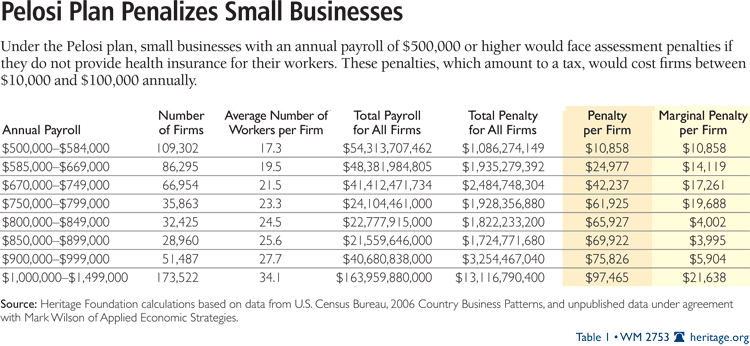As the President, the House Speaker, and the Senate-Majority Leader continue closed-door negotiations on a final health care reform bill, they should reacquaint themselves with the crippling impact the employer mandate penalties would impose on small businesses.
The House-passed bill, for example, would create an 8 percent payroll tax—even on small businesses with 25 or fewer workers.[1] Businesses expanding total annual payroll to $500,000 would face a $10,000 penalty; this penalty rises to $19,200 for small firms expanding total wages to $750,000. Consequently, this additional cost would create a strong disincentive for small firms to increase compensation or hire additional employees.
Increasing Costs on Small Businesses
The House-passed health care plan (H.R. 3962) outlines a detailed employer mandate that would affect small firms with 25 or fewer employees. (See Table 1.) The bill includes an assessment penalty on businesses with total annual payroll of $500,000 or more that decide not to provide health insurance coverage to their workers.[2] This penalty would effectively impose a new tax on many small businesses.[3]
H.R. 3962 imposes new costs on businesses, regardless of whether they decide to offer health insurance coverage or pay the assessment penalty.[4] It explicitly states that these additional payments for health insurance cannot be directly taken out of an employee’s wages and that any employer-based coverage must satisfy the House-passed plan’s coverage requirements.[5]
Small firms with $500,000 of total annual payroll would have to absorb a $10,000 marginal penalty, which increases to $19,200 on small firms with total annual payroll of $750,000. (See Table 1.) If, for example, a business expanded its total payroll from $499,999 to $500,000, it would incur an incremental (or marginal) penalty of $10,000. This impact holds at each specified threshold, increasing to a $19,200 incremental cost for a business expanding total payroll from $749,999 to $750,000. Thus, the employer mandate structure in the House-passed health care bill would create a strong disincentive for a business to expand compensation or even acquire new workers.
How Many Small Businesses Would Be Affected?
The House-passed plan’s employer mandate system is a substantial change from the Senate-passed plan (H.R. 3590), in which firms with 25 or fewer workers not only would be exempt from any type of tax penalty for not offering health insurance coverage but would also qualify for the specified small-firm tax credit. H.R. 3962 eliminates the exemption for firms with 25–49 workers created in H.R. 3590, and a significant number of these firms would face the 8 percent payroll tax.
Moreover, H.R. 3962 imposes a new cost on a majority of small firms with 25–49 workers. A significant number of small businesses could face the full 8 percent penalty if they elect not to provide health care coverage. According to estimates by Mark Wilson of Applied Economic Strategies, there are approximately 330,839 businesses with fewer than 25 workers per firm that would face employer mandate penalties if they elect not to offer coverage—and 32,425 could face the full 8 percent penalty.[6] These estimates also suggest that the total employer mandate penalties for these firms could reach approximately $9,256,891,925.[7]

Businesses Would React to Costs
The 8 percent employer mandate penalty would affect small businesses’ bottom line, and businesses facing new marginal penalties could subsequently determine that it is too costly to expand their labor force.[8] As a consequence of H.R. 3962, companies would have a strong incentive to:
- Outmaneuver the government in reaction to these penalties and
- Find a way to absorb these costs.
These changes do not exactly have to take the form of firing some of the labor force or changing the labor force mix to weigh more heavily on part-time or contract workers. Firms would likely have a strong incentive to change both the level and distribution of compensation.
For example, companies would likely reconsider any bonus and raise that would move the firm above a specified total payroll threshold so that they would not have to incur a higher marginal assessment penalty. Where the marginal cost of expanding compensation is too high, many firms would determine that it is easier to contain wages.[9] Thus, firms with a high composition of low-income, low-skilled workers would likely reduce wages in order to offset the additional costs.[10]
Leave Small Businesses Alone
Again, federal health care reform cannot ignore how such legislation’s employer coverage mandates would negatively affect small businesses. The House-passed health care bill eliminates the exemption for businesses with 25–49 workers that is created in the Senate-passed bill, and it would also impose new marginal penalties on small firms with 25 or fewer workers. This would create a punitive cost that would significantly raise the costs for businesses on the margin.[11]
Since firms of all sizes make decisions on the margin, establishing steep marginal costs for expanding would create strong disincentives for small firms to expand. Moreover, altering these incentive structures is harmful to small businesses and the way they allocate labor, which would ultimately lead to a slower, less robust economy—and labor market. Federal health care reform legislation, therefore, should avoid creating steep new incremental (marginal) costs relating to business growth—particularly in terms of wages and worker compensation.[12]
John L. Ligon is a Policy Analyst in the Center for Data Analysis at The Heritage Foundation.



